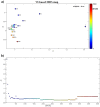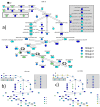Functional aspects of the EGF-induced MAP kinase cascade: a complex self-organizing system approach
- PMID: 25372488
- PMCID: PMC4221048
- DOI: 10.1371/journal.pone.0111612
Functional aspects of the EGF-induced MAP kinase cascade: a complex self-organizing system approach
Abstract
The EGF-induced MAP kinase cascade is one of the most important and best characterized networks in intracellular signalling. It has a vital role in the development and maturation of living organisms. However, when deregulated, it is involved in the onset of a number of diseases. Based on a computational model describing a "surface" and an "internalized" parallel route, we use systems biology techniques to characterize aspects of the network's functional organization. We examine the re-organization of protein groups from low to high external stimulation, define functional groups of proteins within the network, determine the parameter best encoding for input intensity and predict the effect of protein removal to the system's output response. Extensive functional re-organization of proteins is observed in the lower end of stimulus concentrations. As we move to higher concentrations the variability is less pronounced. 6 functional groups have emerged from a consensus clustering approach, reflecting different dynamical aspects of the network. Mutual information investigation revealed that the maximum activation rate of the two output proteins best encodes for stimulus intensity. Removal of each protein of the network resulted in a range of graded effects, from complete silencing to intense activation. Our results provide a new "vista" of the EGF-induced MAP kinase cascade, from the perspective of complex self-organizing systems. Functional grouping of the proteins reveals an organizational scheme contrasting the current understanding of modular topology. The six identified groups may provide the means to experimentally follow the dynamics of this complex network. Also, the vulnerability analysis approach may be used for the development of novel therapeutic targets in the context of personalized medicine.
Conflict of interest statement
Figures





Similar articles
-
Computational modeling of the dynamics of the MAP kinase cascade activated by surface and internalized EGF receptors.Nat Biotechnol. 2002 Apr;20(4):370-5. doi: 10.1038/nbt0402-370. Nat Biotechnol. 2002. PMID: 11923843
-
Growth factor-induced MAPK network topology shapes Erk response determining PC-12 cell fate.Nat Cell Biol. 2007 Mar;9(3):324-30. doi: 10.1038/ncb1543. Epub 2007 Feb 18. Nat Cell Biol. 2007. PMID: 17310240
-
The shedding of membrane-anchored heparin-binding epidermal-like growth factor is regulated by the Raf/mitogen-activated protein kinase cascade and by cell adhesion and spreading.J Biol Chem. 1999 Oct 1;274(40):28828-35. doi: 10.1074/jbc.274.40.28828. J Biol Chem. 1999. PMID: 10497257
-
Growth hormone alters epidermal growth factor receptor binding affinity via activation of extracellular signal-regulated kinases in 3T3-F442A cells.Endocrinology. 2004 Jul;145(7):3297-306. doi: 10.1210/en.2003-1658. Epub 2004 Apr 7. Endocrinology. 2004. PMID: 15070853
-
The epidermal growth factor network: role in oocyte growth, maturation and developmental competence.Hum Reprod Update. 2018 Jan 1;24(1):1-14. doi: 10.1093/humupd/dmx029. Hum Reprod Update. 2018. PMID: 29029246 Review.
References
-
- Cooper GM (2000) The Cell. A Molecular Approach. 2nd edition. Boston University Sunderland (MA): Sinauer Associates.
-
- Schneider MR, Wolf E (2009) The epidermal growth factor receptor ligands at a glance. J Cell Physiol. 218: 460–466. - PubMed
-
- Yarden Y, Sliwkowski MX (2001) Untangling the ErbB signalling network. Nat Rev Mol Cell Biol. 2: 127–137. - PubMed
-
- Hynes NE, Lane HA (2005) ErbB receptors and cancer: the complexity of targeted inhibitors. Nat Rev Cancer 5: 341. - PubMed
-
- Burgess AW, Cho HS, Eigenbrot C, Ferguson KM, Garrett TP, et al. (2003) An open and- shut case? Recent insights into the activation of EGF/ErbB receptors. Mol Cell 12: 541–552. - PubMed
Publication types
MeSH terms
Substances
LinkOut - more resources
Full Text Sources
Other Literature Sources
Research Materials

